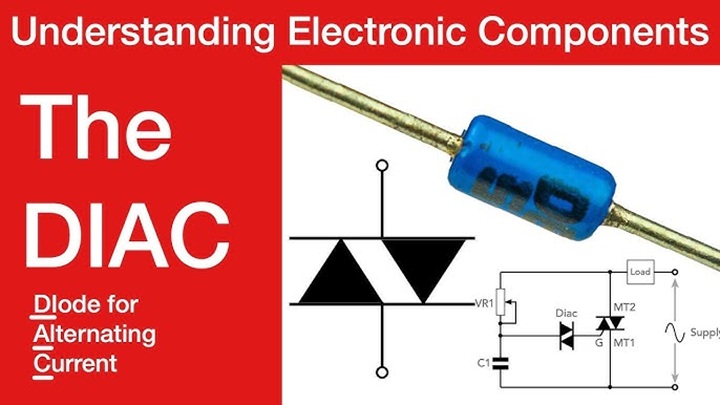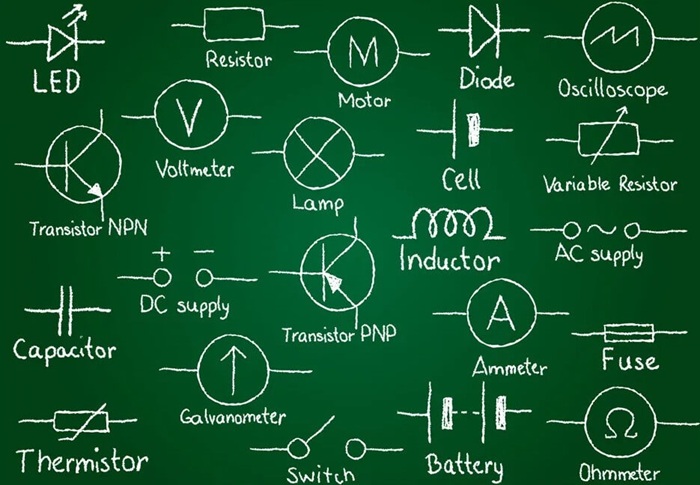Electronic and electrical components abound with symbols that enable engineers and students to recognize devices immediately in circuit diagrams. One of such important components is the DIAC. The symbol for the DIAC is small and simple but a form of special semiconductor device that helps control electricity.
DIAC is less familiar than a diode or a transistor but plays an important role in switching, triggering, and regulating alternating current. If you’ve ever been able to make a fan speed up or slow down, or a light brighten or dim, a DIAC was probably responsible. Here in this article, we’re going to explain the symbol of the DIAC, what it means, its shape, and its use in simple language.
What Is a DIAC
DIAC stands for Diode for Alternating Current. It is an electronic device standardized to allow current flow only when the voltage supplied across it is a given quantity, the breakover voltage.
While a regular diode flows in one direction, the DIAC will flow in both directions once it has been initiated. That makes it a bidirectional device used mainly in AC circuits.
Key Facts about DIAC:
• Full name: Diode for Alternating Current
• Type: Semiconductor switch
• Direction of conduction: Both
• Number of terminals: Two
• Fundamental purpose: TRIAC and AC circuit trigger device
DIAC Symbol
The DIAC symbol is small but descriptive. It consists of two triangles facing each other with a line between them.
Symbol representation:
/|\|/\/\/\\\
Or better depicted by two diodes facing opposite directions with no gate terminal.
This means that DIAC is able to conduct current in both directions if a threshold voltage is reached.
Symbol meaning:
• Two reversed triangles represent two diodes in reverse parallel.
• The vertical stroke between them represents the switching point.
• There are no positive or negative ends (no cathode or anode) but terminal 1 (T1) and terminal 2 (T2).
DIAC Structure
Although the symbol looks simple, the internal structure of a DIAC is made up of three layers and two junctions (PN-P or NP-N).
Principal elements within the DIAC:
• Silicon semiconductor material
• Three alternating layers of P and N types
• Two terminals attached to the outer layers
When voltage is applied across terminals, one junction is forward-biased while the other junction is reverse-biased. Once the voltage exceeds a certain value, both the junctions become conductive, and current flows through the DIAC.
Principle of Operation of DIAC
The DIAC remains non-conductive (off) until the breakover voltage level is attained across the DIAC. After this voltage level is attained, the DIAC is switched on, and current flows.
Steps of operation:
- AC voltage is applied between DIAC terminals.
- When voltage is below the breakover, DIAC is an open circuit.
- When the voltage rises above the breakover point, the DIAC acts as a conductor.
- On passage of current, voltage across it drops sharply.
- When the current reduces again, DIAC gets switched off automatically.
Important point:
The DIAC conducts current in both directions and thus proves of great use in AC applications where current keeps on reversing direction continuously.
Symbol Meaning in Circuit Diagrams
In an electrical or electronic circuit diagram, the symbol for DIAC signifies that the device carries current in both directions when triggered.
What the DIAC symbol shows:
• It’s a symmetrical device (no polarity).
• It won’t conduct below the threshold voltage.
• It can act as a switch for AC circuits.
• It is normally used before a TRIAC in a circuit.
Circuit Representation of DIAC
A DIAC is normally used in series with the gate terminal of a TRIAC to aid its triggering.
Simple Diagram:
AC Source → Resistor → Capacitor → DIAC → TRIAC → Load
In this, DIAC is used as the triggering device for the TRIAC, which controls power fed to the load (like a bulb or a fan).
Comparison of Symbol with Other Devices
| Device | Shape of Symbol | Operation | Type of Current |
| Diode | One triangle and one line | Handles current in one direction | DC |
| Zener Diode | Triangle with sloping line | Handles voltage | DC |
| DIAC | Two triangles facing opposite directions | Conducts in both directions | AC |
| TRIAC | DIAC with gate terminal | Controls AC power | AC |
The DIAC symbol looks like two diodes placed side by side in opposite directions, and the TRIAC has a third terminal (the gate) for control.
Properties of DIAC
The DIAC has some special electrical properties.
Important properties:
• Bidirectional conduction: Works in both directions of AC.
• Breakover voltage: Minimum voltage to trigger it to fire, typically between 30 to 50 volts.
• Switching action: Abrupt switch-on when breakover voltage is reached.
• Symmetrical behavior: Equally conducts in both directions.
• Small size: Suitable for small spaces in circuits for use.
Applications of DIAC
The DIAC symbol is used in most circuit schematics, especially where AC current control is necessary.
Common applications:
• Dimming of lights
• Speed controllers for fans
• Heater control circuits
• Triac trigger circuits
• AC power phase control
• Motor speed control circuits
In each of these applications, the DIAC provides smooth triggering and noise suppression in the circuit.
Example: DIAC in Light Dimmer Circuit
In a light dimmer circuit, a DIAC triggers a TRIAC that controls the duration of electricity flowing through the light bulb within an AC cycle.
Working:
• The capacitor charges until voltage at DIAC breakover.
• DIAC firing, shooting a pulse to the gate of TRIAC.
• TRIAC is turned on and sends current to the bulb.
• TRIAC turns off when current reduces, and the cycle repeats.
This cycle generates smooth control of brightness.
Symbol and Polarity
The symbol of DIAC is not indicated with polarity since it is symmetrical. Any of the terminals can be used to connect either side of the circuit.
• T1 and T2 are used to refer to terminals.
• No positive or negative side exists.
• Performs in the same manner for both half cycles of AC.
Advantages of DIAC
- Works for both directions of AC
• Provides stable triggering of TRIAC
• Reduces electrical noise
• Provides higher efficiency of control circuits
• Small and inexpensive
Disadvantages of DIAC
- Unable to handle large current directly
• Works only as a trigger and not as an entire power controller
• Non-adjustable fixed breakover voltage
Symbol in Textbooks and Diagrams
The symbol for DIAC is typically presented in the majority of circuit textbooks as:
/|\\|/\\\\\\
or
>| |<
joined between two terminals.
Whenever you come across this symbol, it indicates DIAC, a small but powerful device used for AC control.
Construction and Materials
DIACs are usually built on silicon wafers and encapsulated in a very small plastic or metal package. The internal P-N-P or N-P-N structure enables conduction in both directions.
They are usually built as PNPN or NPNP layered structures, similar to a TRIAC but without the gate.
Practical Example of DIAC Symbol Use
Suppose you open the schematic of a ceiling fan regulator. You might find there a small device marked “DB3” or “DB4.” It is a DIAC. The DB3 DIAC has a breakover voltage around 32V and is used to trigger a TRIAC in phase-control circuits.
Fun Facts about DIAC
- DIAC means “Diode for Alternating Current.”
• It always works together with TRIAC in real circuits.
• Its major function is to supply a short voltage pulse.
• It has no moving parts, so it can be used for long periods without safety risks.
• DB3 is the most common DIAC that is used in small appliances.
Safety and Handling Instructions
- Never use DIAC with DC circuits as it works on AC only.
• Use only proper voltage ratings to avoid damage.
• Store DIACs in anti-static covers to protect from static electricity.
• Test breakover voltage before replacing one in a circuit.
DIAC vs TRIAC Comparison Table
| Feature | DIAC | TRIAC |
| Terminals | 2 | 3 |
| Conducts | Both directions | Both directions |
| Trigger | Self-triggered | Triggered by gate |
| Application | Triggering | Power control |
DIAC’s symbol may look small, but it has a very important function in today’s electric control systems. The two triangles facing each other tell us that it can work in both directions and help devices like TRIACs to work well.
It is the most universal but vital component in light dimmers, motor speed regulators, and many household appliances.
So whenever you see the logo of two opposite arrows with a line between them, just remember that it is the DIAC, the silent switch that initiates your lights gradually glowing and your fans gradually rotating.


